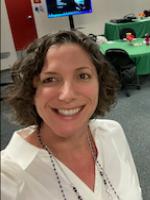



It is vital that we strive to provide equitable access to services, curriculum, and technology while providing all students the needed digital learning skills for success in college, career, and life. The purpose of our session is to share our successes and challenges of this high level goal over the past two years, and how we have created structures and systems to bring these ideals to the reality of student success in classrooms.
Replicable actions participants will learn in this session include:
Surveying stakeholders to guide the creation of a shared vision for digital learning
Aligning learning science research to a digital learning plan
Developing district informed, ISTE standards guided grade level expectations for digital learning - to ensure clarity, skills progressions, and opportunity to maximize opportunities via contextual, interdisciplinary learning & in alignment to district goals for career/college readiness
Building a professional learning plan to support educators (badging, peer learning, coaching, lesson exemplar creation)
This session was created to address the reality that districts across the globe increased student access to technology exponentially at the advent of the global pandemic, but often struggle to maintain momentum and ensure that digital learning is effective. Our presentation illustrates how we systematically integrated ISTE standards for students districtwide, in alignment with learning sciences, in order to build upon this momentum.
Evidence of success include proof of implementation of digital learning plan and grade level expectations via observational walkthroughs, surveys, coaching logs, badging participation results based on time on task and badges earned, and exemplary lesson creation.
Agenda for this session includes -
Participants reflect: Nearpod will be used for participants to identify barriers to implementation for digital learning via collaboration board. (2 minutes)
Setting the Foundation: Presenters discuss district actions re: develop initial drafts of the digital learning plan, grade level expectations and sample lessons with county consultant, district librarian, and IT Director. Participants view digital learning plan and notate in shared Nearpod platform their noticings and wonderings about the plan. Participants review understanding of brief review of grade level expectations via nearpod time to climb activity (20 minutes)
Developing a Shared Vision: Presenters discuss district actions re: convene multiple meetings (STS, Coaches, ATM, etc.) for review, feedback, and problem solving to engage and be responsive to stakeholders. (5 minutes)
Soliciting Input from Stakeholders: Presenters discuss district actions re: conduct parent forums, interviews, and surveys to ensure that all stakeholders contribute to the development of the district technology plan. Survey data will be shown. Participants reflect upon their predictions of their own hypothetical survey data. (10 minutes)
Building Ownership: Presenters discuss district actions re: Facilitate a pilot of willing teachers in the Spring to test out the tenets of the technology plan, grade level expectations, and sample lessons. Seek board approval. (5 minutes)
Rollout: Presenters discuss district actions re: plan and communicate appropriate professional development during the summer and fall for implementation starting in the fall of 2022 and continuing throughout the year. (10 minutes)
Research shows that rural districts have more difficulty implementing 1:1 programs due to several factors, such as reliable internet access, the ability to refresh devices, and providing ample professional development to teachers (Powers, J. et. al., 2020). Though the move to student 1:1 was necessitated by the pandemic, it is not likely to be discontinued from this point on. Additionally it is understood teacher pedagogy for technology instruction needs to be adequately supported in order for the technology to be properly utilized to support 21st Century learners.
In the book Closing the Gap, digital equity is discussed as the devices plus connectivity plus instruction. Having access to the devices is part of the equation, while transforming the education process through instruction is the other vital feature (Schaffer, R. et. al., 2019, p. 15-20). A key dynamic in balancing equity for students is to ensure the way in which they are utilizing technology is creative and innovative while utilizing 21st century skills, such as using the SAMR method in conjunction with ISTE standards (Schaffer, R. et. al., 2019, p. 28). The “how” students utilize their technology tools counts just as much as the technology device (Smith, T., & Amouzou, W., 2018). Incorporating student voice and choice increases engagement and creativity. With these demands come the need for teacher professional development. Increasing teachers' ability to successfully utilize technology as a tool to improve students' learning requires time for collaboration and training. Innovation does not happen overnight and needs to be a district wide focus with emphasis on “ongoing and embedded support” (Schaffer, R. et. al., 2019, p. 44).
Having a focused district framework for incorporating technology use is vital for common language as teachers design lessons for one to one instruction. Kolb discusses SAMR, TPACK, and TIM as prior frameworks, and then expands on those frameworks to explain the Triple E Framework (engagement, enhancement, and extension) that is intricately woven into the The International Society for Technology in Education (ISTE) standards (Kolb, 2017, p.30-36). Additionally, the ISTE standards are carefully developed to support 21st century learners. Developing training for teachers around utilizing a common tool creates coherence across grade levels and added equity for students.